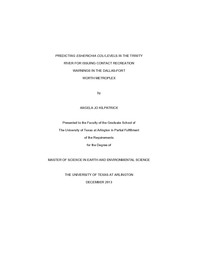| dc.contributor.author | Kilpatrick, Angela Jo | en_US |
| dc.date.accessioned | 2014-03-12T23:52:44Z | |
| dc.date.available | 2014-03-12T23:52:44Z | |
| dc.date.issued | 2014-03-12 | |
| dc.date.submitted | January 2013 | en_US |
| dc.identifier.other | DISS-12436 | en_US |
| dc.identifier.uri | http://hdl.handle.net/10106/24164 | |
| dc.description.abstract | E. coli is an indicator for the potential of waterborne illness. However, tests for E. coli take 18 to 24 hours to produce results. During this time, citizens may be exposed to high levels of bacteria. As contact recreation increases in the Trinity River through the Dallas-Fort Worth Metroplex, methods to predict E. coli levels from instantaneously measured water quality parameters may provide a better way to protect public health than the current standard methods.Predictive models were created using multiple linear least-squares regression for the three segments of the Trinity River that flow through the Dallas-Fort Worth Metroplex. Initial results of the models are encouraging in that they reasonably predict E. coli levels in these segments, but additional validation data is needed. The methods described herein may be applicable to other entities interested in developing prediction models for E. coli in their watersheds. | en_US |
| dc.description.sponsorship | Grover, James P. | en_US |
| dc.language.iso | en | en_US |
| dc.publisher | Environmental & Earth Science | en_US |
| dc.title | Predicting Esherichia coli Levels In The Trinity River For Issuing Contact Recreation Warnings In The Dallas-Fort Worth Metroplex | en_US |
| dc.type | M.S. | en_US |
| dc.contributor.committeeChair | Grover, James P. | en_US |
| dc.degree.department | Environmental & Earth Science | en_US |
| dc.degree.discipline | Environmental & Earth Science | en_US |
| dc.degree.grantor | University of Texas at Arlington | en_US |
| dc.degree.level | masters | en_US |
| dc.degree.name | M.S. | en_US |

